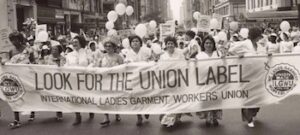
The International Ladies' Garment Workers' Union
*Black history and the International Ladies' Garment Workers' Union (ILGWU) are affirmed on this date in 1900.
The ILGWU, whose members worked in the women's clothing industry, was once one of the largest labor unions in the United States, and one of the first U.S. unions to have a primarily female membership and significant influence on labor history during the 1920s and 1930s. The ILGWU was founded in New York City by seven local unions; the union multiplied but began to stagnate as the conservative leadership favored the interests of skilled workers, such as cutters. This did not sit well with most immigrant workers, particularly Jewish workers with a background in Bundist activities in Tsarist Russia, or with Polish and Italian workers, many of whom had strong socialist and anarchist leanings.
The ILGWU was able to turn the partial victory of the Great Revolt into a lasting victory; within two years, it had organized roughly ninety percent of the cloak makers in the industry in New York City. It improved benefits in later contracts and obtained an unemployment insurance fund for its members in 1919. At the same time, political splits within the union were growing. The Socialist Party split in 1919, with its left wing to form the Communist Party USA. Those left-wing socialists challenged the undemocratic structure of the ILGWU, which gave every local an equal vote in electing its leaders, regardless of the number of workers the local represented and the accommodations the ILGWU leadership had made in bargaining with employers.
Left-wing activists, drawing inspiration from the shop stewards' movement that had swept through British labor in the preceding decade, started building their strength at the shop floor level. The Communist Party did not intervene in ILGWU politics until around 1921, as it sought to establish a base among the working class and within the AFL unions. The party experienced its most tremendous success and failure in the 1920s in the garment trades, where workers had experience with mass strikes, and socialist politics were part of the everyday discourse. In the late 1920s, the ILGWU focused on recruiting African American women. Floria Pinkney, a Black dressmaker, played a pivotal role in this focus. Pinkney spoke alongside the president of the Brotherhood of Sleeping Car Porters. At a 1929 ILGWU meeting in Harlem, A. Philip Randolph emphasized the importance of enrolling Black women.
The union's membership shifted from being predominantly Jewish and Italian to include immigrant workers, mainly from Puerto Rico, the Dominican Republic, and China in New York, as well as from Mexico, Central America, and Asia in Los Angeles and other western and southern centers of the industry. The union's leadership had less and less in common with its membership and very often had no experience in the trade itself. The union won few gains in workers' wages and benefits in the years after World War II. It gradually lost its ability to prevent sweatshop conditions from returning, even in its former stronghold, New York.
In the last decade of David Dubinsky's tenure as the ILGWU's leader, some of these new members began to rebel, protesting their exclusion from positions of power within the union. That rebellion failed: the established leadership had too strong a hold on the official structure of the union in an industry in which members were scattered across several small shops and in which power was concentrated in the upper echelons of the union rather than in the locals. Without the support of a mass movement that would have given the majority a compelling voice, individual insurgents were either marginalized or co-opted.
The union also found it nearly impossible to organize garment workers in communities such as Los Angeles, even when going after established manufacturers. Organizing on a shop-by-shop basis proved ineffective, given the prevalence of "fly by night" contractors, the number of workers willing to take jobs vacated by striking or fired workers, the uncertain immigration status of many workers, and the kinship connections that bound many workers to their foremen and other low-level managers. The union found itself in 1995 in nearly the same position it had been in more than ninety years earlier, but without any prospect of the mass upsurge that had produced the general strikes of 1909 and 1910.
The union, generally referred to as the "ILGWU" or the "ILG," merged with the Amalgamated Clothing and Textile Workers Union in the 1990s to form the Union of Needle Trade, Industrial, and Textile Employees (UNITE). In 2004, UNITE merged with the Hotel and Restaurant Employees Union (HERE) to create a new union known as UNITE HERE. The two unions represented 250,000 workers, down from the ILGWU's peak membership of 450,000 in 1969.